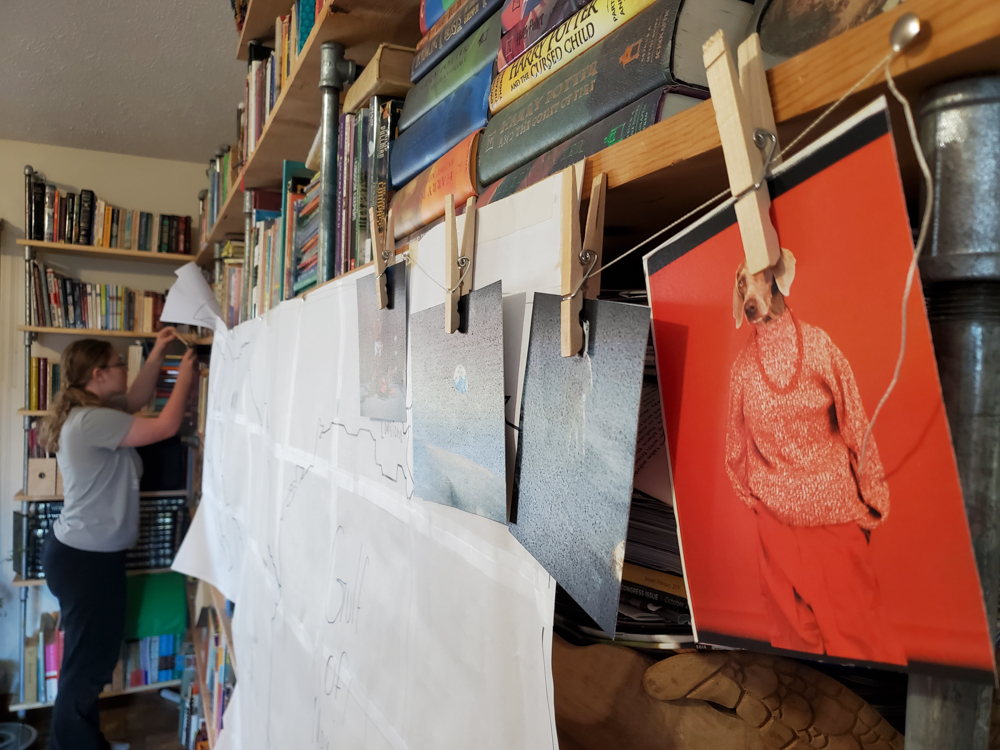We must be home again!
We left a few projects in the lurch for our trip--our bat house, the thankful tree, the Disaster Dioramas of Pompeii and the Titanic, a whole slew of Spanish flashcards--and every now and then, as the kids decompress and I continue my manic run through the holiday craft fair season, we're picking them all back up again.
For instance, we finally finished a project that we've been working on for a while--putting all the Magic Tree House books in their proper spot on our huge basement timeline. Because the kids listen to the Magic Tree House audiobooks over and over again, they've gained quite a bit of historical and geographical knowledge, but it can be tough putting that into a wider context, and wider contexts is what I am all about.
So I sent Matt thumbnails of every Magic Tree House book cover for him to lay out and print, and I made a list of where each relevant book belongs on our timeline. Want to see my list? It's pretty great:
- #1 Dinosaur Before Dark--Cretaceous period
- #2 The Knight at Dawn--Middle Ages
- #3 Mummies in the Morning--2630 BCE to 2250 BCE
- #4 Pirates Past Noon--1690-1730
- #5 Night of the Ninjas--1336-1600
- #7 Sunset of the Sabertooth--Late Pleistocene period
- #8 Midnight on the Moon--2036
- #10 Ghost Town at Sundown--1850-1900
- #13 Vacation under the Volcano--79 CE
- #14 Day of the Dragon King--first century
- #15 Viking Ships at Sunrise--9th century
- #16 Hour of the Olympics--776 BCE-393 CE
- #17 Tonight on the Titanic--1912
- #18 Buffalo before Breakfast--1850-1900
- #21 Civil War on Sunday--1861-1865
- #22 Revolutionary War on Wednesday--12/25/1776
- #23 Twister on Tuesday--1870s
- #24 Earthquake in the Early Morning--1906
- #25 Stage Fright on a Summer Night--1558-1603
- #27 Thanksgiving on Thursday--1621
- #28 High Tide in Hawaii--11th century-1777
- #29 A Big Day for Baseball--1947
- #30 Hurricane Heroes in Texas--1930
- #31 Warriors in Winter--100s CE
- #32 To the Future, Ben Franklin!--1787
- #33 Narwhal on a Sunny Night--975-990
- #34 (old numbering--now it's Merlin Mission #6) Season of the Sandstorms--prior to the 8th century
- #34 Late Lunch with Llamas--15th century
- #35 (old numbering--now it's Merlin Mission #7) Night of the New Magicians--1889
- #35 Camp Time in California--1903
- #36 (old numbering--now it's Merlin Mission #8) Blizzard of the Blue Moon--1938
- #37 Dragon of the Red Dawn--1185-1603
- #38 Monday with a Mad Genius--around 1500
- #39 Dark Day in the Deep Sea--1870s
- #41 Moonlight of the Magic Flute--1760
- #42 A Good Night for Ghosts--1916
- #43 Leprechaun in Late Winter--1860
- Merlin Mission #17 A Crazy Day with Cobras--1500-1600
- Merlin Mission #18 Dogs in the Dead of Night--1600s
- Merlin Mission #19 Abe Lincoln at Last--1861
- Merlin Mission #20 A Perfect Time for Pandas--2008
- Merlin Mission #21 Stallion by Starlight--340 BCE
- Merlin Mission #22 Hurry Up, Houdini!--1915
- Merlin Mission #23 High Time for Heroes--1849-1850
- Merlin Mission #24 Soccer on Sunday--1970
- Merlin Mission #25--Shadow of the Shark--before 1511
- Merlin Mission #26 Balto of the Blue Dawn--1925
Sydney helped me cut out all the book cover thumbnails, then Willow glued them onto the wall as I showed her where each one went. She coated each in an extra layer of glitter glue, just because, and then I went back and wrote in the timeline info:

But last night they listened to this book as they fell asleep:





























.jpg)
.jpg)
.jpg)
.jpg)
.jpg)
.jpg)
.jpg)